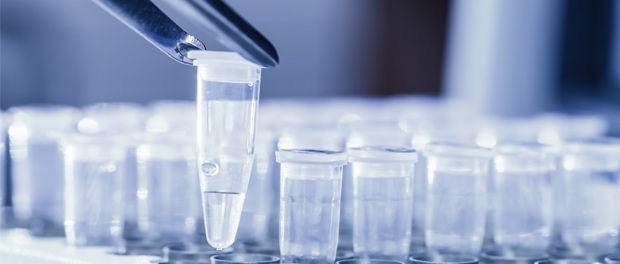“The function of Taq DNA polymerase in PCR is to amplify or synthesize DNA or gene of interest for various downstream applications. It’s a type of thermostable DNA polymerase, work at a higher temperature as well.”
PCR- Polymerase Chain Reaction has a wide range of applications in genetic science. A PCR amplifies a gene or DNA sequence which we wish to study. An rt-PCR, a variant of the native PCR, can quantify a target as well.
It has applications in biotechnology, biological sciences, microbiology, environmental science, archaeology and forensic science, etc. Scientists are using it in gene expression, gene therapy, gene transfer, DNA sequencing and gene cloning like experiments.
In cyclic-temperature conditions, PCR copies a gene of interest by denaturation, annealing and extension. If you want to learn more, you can read our previous in-depth article here: Polymerase chain reaction.
To enable amplification, a PCR needs an enzyme, a polymerase that can help in synthesis.
DNA polymerase is a class of enzymes that function to synthesize DNA during DNA replication. Replication is the process of synthesizing or copying DNA in vivo. It forms two different deoxynucleic acid sequences using DNA polymerase.
The DNA polymerase performs a vital function during a cell’s central dogma specifically, in replication. It makes new DNA strands from the existing strand by adding dNTPs to the growing DNA.
If you wish to learn more, this article will help, read it here: Multifunctional DNA polymerase.
Arther Kornberg discovered DNA polymerase in 1956 and won a Nobel Prize in 1959.
The DNA polymerase has two important activities during replication: 5’ to 3’ polymerase activity and 3’ to 5’ exonuclease proofreading activity. As it binds to DNA, it adds nucleotides in a direction of 5’ to 3’ including mismatch addition too.
The 3’ to 5’ proofreading activity helps in removing mismatch nucleotides. The polymerase moves back to one nucleotide, removes the mismatched nucleotide and reinserts the exact nucleotide back. The mechanism is known as base excision repair.
Increasing temperature decreases enzyme activity.
All enzymes work properly at body temperature which is 37°C. So DNA polymerase has the highest activity at 37°C, higher temperature degrades the enzyme. PCR relies on a higher temperature for denaturation, annealing and extension of DNA strand, primer binding and strand extension, respectively.
So researchers need a special type of polymerase enzyme that can even work at a higher temperature. You may wonder is it possible, is any polymerase exist that can do so?
The answer is Yes. Taq DNA polymerase has overcome this problem.
In the present article, I will explain to you the function of Taq DNA polymerase in PCR. In addition, I will also discuss, definition, activity, advantages and disadvantages too.
I hope the present article will surely help you in your PCR learning and strengthen your knowledge.
Stay tuned,
Key Topics:
What is Taq DNA polymerase?
The Taq DNA polymerase is an enzyme that belongs to the ‘polymerase’ category, do DNA synthesis. It was isolated by Chien et al. in 1976 from Thermus aquaticus eubacteria.
Taq, Taq D Pol, Taq DNA Pol are several names researchers use for it.
Properties:
| Optimum reaction temperature | 72°C |
| Optimum pH | ~9.0 |
| Storage temperature | -20°C |
| Shipping condition | Dry ice |
| Reactions | < 1000 |
| Molecular weight | 95KDa |
| Max amplification | 1500 to 2000bps |
| Volume required | 5 U/µL |
Definition:
“A special class of thermophilic enzyme that can synthesize DNA, even at higher temperatures is known as Taq DNA polymerase.”
The purpose explained:
PCR- a polymerase chain reaction is a temperature-dependent, in vitro, DNA amplification process. Denaturation, annealing and extension are three temperature-dependent steps in PCR. Denaturation occurs at 94°C, annealing at 56°C to 63°C and extension at 72°C.
DNA synthesis needs a polymerase enzyme, however, almost no enzyme can work at a higher temperature. Enzymes have maximum activities at body temperature, 37°C. As temperature increases, the activity gradually decreases.
Henceforth, a normal DNA polymerase can’t work for PCR. And to fulfill in vitro amplification, scientists need a thermostable polymerase enzyme that can work at a higher temperature.
In 1966, during one summer, at Yellowstone national park in the USA, Thomas D Brook discovered a bacteria. He isolated the bacteria from the hot water spring and named it ‘Thermus aquaticus’.
The name Thermus aquaticus meaning, “Hot water bacteria” was derived from its ability to survive in hot water and its aquatic habitat.
Later on, in 1976, Chien et al. isolated polymerase from Thermus aquaticus and named it Taq DNA polymerase. Now, this can overcome the problem that occurs in PCR. The enzyme has great stability between 94°C to 98°C temperature.
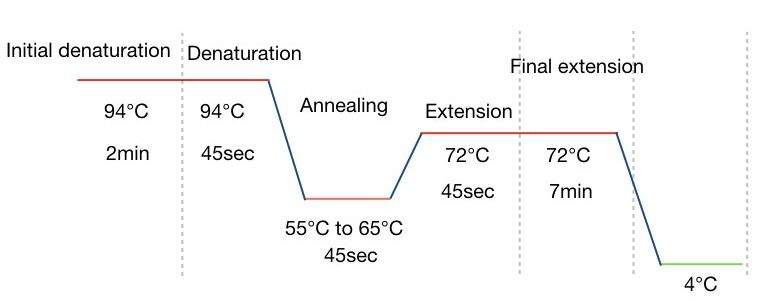
The function of Taq DNA Polymerase:
The Taq has a function to synthesize/amplify/copy the DNA. You may wonder how Taq does do Polymerization?
The present enzyme has stable polymerization activity at temperatures between 70°C and 78°C and may even increase by adding some salts.
When PCR initiates the process, during the first step, the dsDNA denatures and becomes single-stranded. In the next step, the primer binds according to their complementary strand and in the last step, the polymerase amplifies it.
Here, though at temperature 94°C, the Taq remains inactive, immediately starts copying when the temperature reaches 72°C at where the Taq has the highest activity of adding ~150 nucleotides/second.
First, the Taq binds to the substrate, which means to our template DNA and finds the primer-DNA junction. It determines the free 3’ OH end of the primer and uses it to initiate the catalytic activity.
In the next step, it analyses the substrate nucleotide sequence, picks the complementary dNTP and adds it near the 3’ end. It makes hydrogen bonds between opposite nucleotides.
Once it assures binding, it moves to the next nucleotide. Keep in mind that the present DNA polymerase does not have exonuclease activity. Meaning, it can’t correct mismatches (and we even don’t need it!).
The Taq has a lower catalytic at boiling temperature, though it remains stable. It has maximum activity at ~70°C. Using salts such as KCl or MgCl2 can increase the activity and make it more stable.
50mM KCl and 5mM MgCl2 can make Taq stable and act maximally during the reaction. Hence advisable too. Notwithstanding, a higher amount of salt negatively influences the activity too.
Technically, elevated salt concentration induces non-specific bindings. Furthermore, EDTA, a chelating agent inhibits the Taq DNA polymerase activity by blocking ion binding sites.
Taq DNA polymerase activity:
Here I have given a chart of Taq activity at various temperatures.
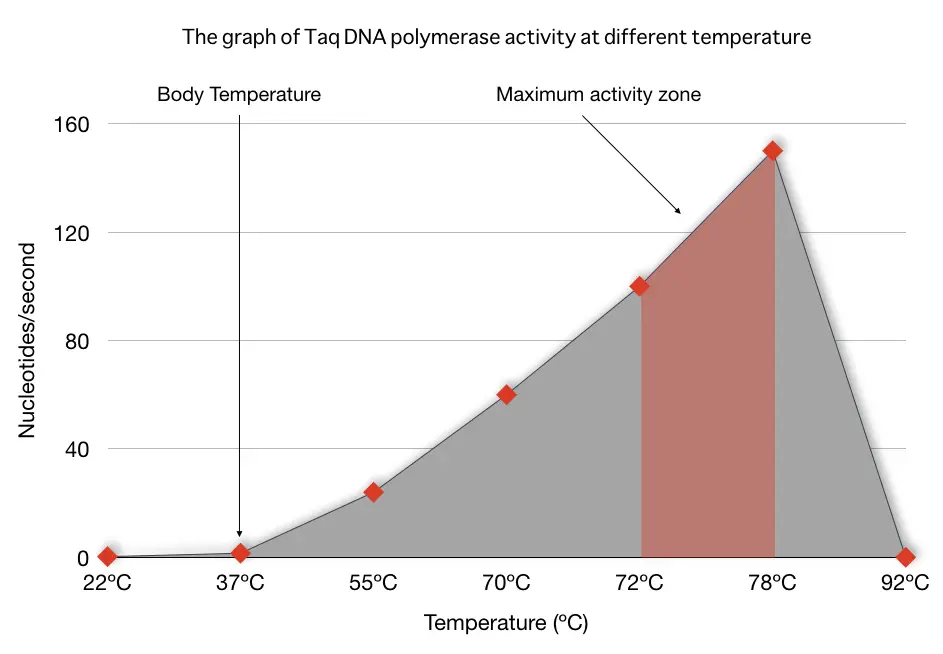
The present enzyme, a type of DNA polymerase, remains stable at 90ºC to 98ºC and can amplify the DNA too. It has a very low catalytic activity above the temperature of 90ºC.
At a temperature of 22ºC, it has the lowest enzymatic activity of 0.25 nucleotides/second. At 37ºC, 55ºC and 70ºC it can add 1.5 nucleotides/second, 24 nucleotides/second and 55 nucleotides/second dNTPs, respectively.
The enzyme has very low catalytic activity at temperatures 22ºC and 37ºC whereas relatively low to moderate activity at 55ºC and 70ºC.
The enzyme can add dNTPs up to 150 nucleotides/second at temperatures between 72ºC to 80ºC showing very high enzymatic activity. Meaning it has an elongation rate of synthesizing 0.9 to 1.2Kb sequence/min at 70ºC to 75ºC.
Note that as we said, sals such as KCl or MgCl2 can boost the enzymatic activity from 2 to 10 fold when used in appropriate concentration. Moreover, it can stably work up to 40 minutes at 95ºC.
In summary, the Taq DNA polymerase has the function to amplify/synthesize DNA by adding dNTPs during PCR. It has maximum catalytic activity at 72 to 75ºC, adding 150 nucleotides at every second. The table showing the activity of Taq,
| Temperature | nucleotide/second | Activity |
| 22ºC | 0.25 | Very low |
| 37ºC | 1.5 | Very low |
| 55ºC | 24 | Relatively low |
| 70ºC | 60 | Relatively low |
| 72 to 80ºC | 150 | Very High |
| 92 to 98 | 0 | Very low |
Taq DNA polymerase domains:
The enzyme consists of two domains: the polymerase and the exonuclease domains.
The Polymerase domain- a larger active site remains bound to the blunt end DNA duplex, formed by primer-template annealing. This readily provides the 3’ OH end for polymerization.
The side amino acid chains of the domain form hydrogen bonds between nucleotides of opposite strands. Overall the polymerase domain remains attached to the exonuclease domain. It does do amplification from 5’ to 3’ direction.
The overall structure of the enzyme is somehow similar to the E. coli PolA. The exonuclease domain has two types of activity in which the 3’ to 5’ activity is suppressed naturally.
The other exonuclease domain is present near the amino acid – terminal of the Taq. However, the central exonuclease domains remain inactive.
Protocol for Taq DNA polymerase:
Here in this section, I will show you the ideal PCR protocol using the Taq DNA polymerase in the PCR reaction.
Keep in mind that “unit” is denoted as “U” is the unit for enzyme activity. Every Taq came in units like the 1.25 U/µL, 5 U/µL or 10U/µL.
- Add 0.5µL 10mM dNPTs.
- Add 1µL each 0.5µL primers.
- Add 2.5 µL, 1 Taq DNA polymerase reaction buffer.
- Add 0.12µL Taq DNA polymerase having 1.25U/µL.
- Add 3 µL template DNA (250 ng)
- Add nuclease-free water to make a final volume of 25µL.
Put tubes in the PCR machine as set the protocol as shown here:
- 95ºC- initial denaturation for 30sec.
- 95ºC- denaturation for 30 sec.
- 55 to 68ºC- annealing for 15 to 60 sec.
- 72ºC- extension for 50 sec.
- 72ºC- Final extension for 5 minutes.
Perform 30 to 35 cycles of denaturation-annealing and extension.
Taq DNA polymerase kit:
Two types of Taq kits are now commercially available, either direct PCR amplification kit (including mastermix, reaction buffer and Taq DNA polymerase in a single kit) and a separate Taq DNA polymerase amplification kit.
The separate kit consists of 5 U/µL or 10 U/µL Taq DNA polymerase and a vial of Taq DNA polymerase reaction buffer. The reaction buffer has ideally MgCl2, KCl and (NH4)2SO4. It also consists of a few secret ingredients that companies aren’t disclosed. The buffer has 25mM MgCls, 500 mM (NH4)2SO4, 50mM KCl.
Note that store the kit at -20ºC. A typical Kit consists of 100 units of 5 U/µL Taq DNA polymerase.
Read more: The Function of dNTPs in PCR Reaction.
Several advantages and disadvantages of it are enlisted below,
Advantages of Taq DNA polymerase:
- Thermostable: The enzyme is heat-resistant and remains stable even at boiling temperature. It’s a thermostable thats why!
- Efficiency: It is highly efficient. As it is reached at its optimum temperature, the thermostable polymerase becomes fully functional and adds nucleotides to the growing DNA strand.
- High amplification capacity: It can insert 150 nucleotides per second during amplification. Meaning can make a DNA sequence up to 1.2Kb in a minute.
- The half-life of thermostable polymerase is higher than any other commercially available polymerase. Taq has a half-life of more than 2 hours at a temperature of 92°C.
Disadvantages of Taq DNA polymerase:
- Low Specificity: It has poor specificity, meaning, it can add wrong nucleotides during synthesis and can’t even repair. A minor temperature fluctuation adversely influences enzyme activity.
- Low fidelity: Taq does not have 3’ to 5’ exonuclease proofreading activity, so it cannot correct mismatched nucleotides.
- Unidirectional activity: Again, it has unidirectional activity from 5’ to 3’ therefore it can’t go back for base excision repair.
- Bivalent cation requirement: The enzyme requires cofactors to work efficiently. The Taq DNA polymerase always needs an Mg2+ ion as a cofactor.
However, nowadays, high-fidelity Taq DNA polymerase, specific Taq DNA polymerase and high sensitive DNA polymerase are commercially available depending upon the type of PCR reaction.
Read our article on it: Choosing the right DNA polymerase for your PCR experiment.
Comparison of DNA polymerase and Taq DNA polymerase:
|
Properties |
DNA polymerase |
Taq DNA polymerase |
|
Activity |
5’ to 3’ polymerase activity and 3’ to 5, proofreading activity |
5’ to 3’ polymerase activity |
|
Optimum temperature |
37°C |
72°C |
|
Thermostability |
Stable at 37°C |
Stable at 92°C |
|
Fidelity |
Higher |
Low |
|
Additional cofactor |
Not require |
Require |
|
Applicability |
In vivo |
In vitro |
Applications of Taq DNA polymerase:
- The enzyme has a great utility in conventional PCR assays having an elongation capacity of up to 5Kb.
- The conventional PCR, quantitative PCR and rtPCR rely on the Taq DNA polymerase.
- It has been used in high throughput PCR screening.
- The Taq also has fabulous service in the DNA labeling process.
Optimization of Taq DNA polymerase:
The commercially available Taq DNA polymerase has more stability at a higher temperature. The issue with using the Taq is its specificity. It incorporates mismatches during amplification and has no power to repair them.
In addition, the chances of non-specific bindings are very high too. Interestingly, the Taq DNA polymerase remains inactive at a lower temperature. Thus to avoid unnecessary amplification, prepare your PCR reaction on ice.
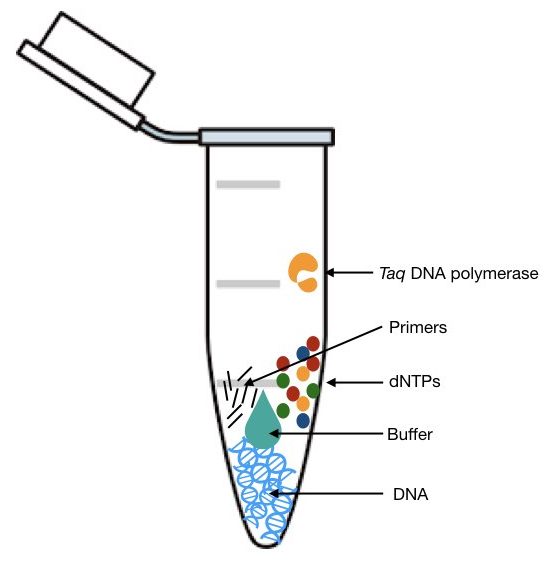
Always, prefer to add Taq DNA polymerase at the end of the reaction, after adding all ingredients. As it reaches late in the reaction, it minimizes the chances of non-specific bindings.
Aliquot the enzyme into different tubes. Taq is an enzyme, a sensitive component of biological reaction so we have to store it in cool. Store one working tube at 4°C and stock at -20°C.
Wear gloves to avoid contamination.
The Taq is highly demanding!
The activity of Taq greatly relies on cofactors such as MgCl2 for performing well during the reaction. Although the ready-to-use PCR buffer already has MgCl2 in it, adding some can elevate amplification.
Read our article on how to use MgCl2 in PCR: Role of MgCl2 in PCR reaction
Remember! Too much Taq decreases reaction specificity, you will get more bands in agarose gel. Thus always use Taq as per manufacturers instructions.
Hot start PCR is the best option for the high sensitive PCR reaction. For those reactions, in which we can’t afford any non-specific binding, we need a specialized setup.
Scientists use Taq-specific antibodies to block its early activity (during reaction preparation).
Once tubes are transferred to PCR and heated at 94°C, it releases the antibody, destroys it and makes Taq DNA polymerase available for the reaction.
This technique has high accuracy and specificity. Hot start PCR kits are now commercially available, so don’t worry about that.
Transport enzymes in the cold chain.
Amplicon (PCR enzyme and Reagents) has performed an interesting study showing the enzyme activity at different storage and shipping temperature conditions. They selected transport temperatures of 5°C, 25°C and 40°C and measured enzyme activity at 0, 2, 4, 6, 8 weeks.
Broadly, their results show that the enzyme remains in an excellent state at 5°C temperature even after 24 months. And gave outstanding results at different DNA concentrations.
The results at 40°C even after 8 weeks are worse. The pictorial representation of their study is shown here
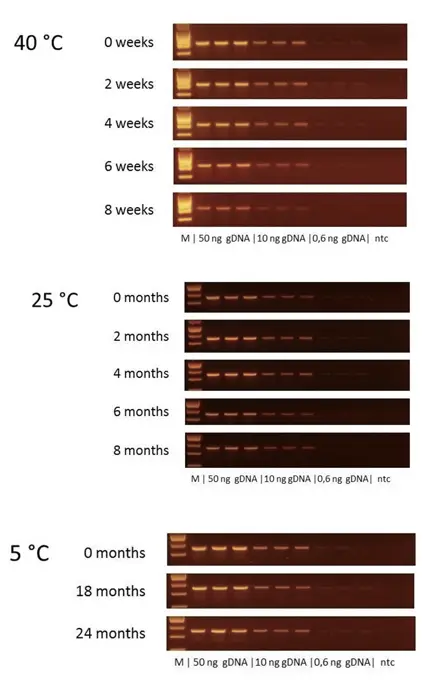
Conclusion:
As the function of Taq DNA polymerase is to amplify the target DNA, we can’t imagine a PCR without it. It’s a revolutionary discovery that changed the practical approach of genetics.
The commercially available enzyme only has a large polymerization domain only. It has an error rate of 2.2 x 10-5 errors per nt per cycle.
I have one last question for your people,
The Taq has limited activity, it can add nucleotides up to 1500bps So what are the options to perform the long-range PCR? Is there any other alternative of Taq commercially available?
Please comment and let me know.
Sources:
Ishino S, Ishino Y. DNA polymerases as useful reagents for biotechnology – the history of developmental research in the field. Front Microbiol. 2014;5:465. Published 2014 Aug 29. doi:10.3389/fmicb.2014.00465.
Moazen F, Rastegari A, Hoseini SM, Panjehpour M, Miroliaei M, Sadeghi HM. Optimization of Taq DNA polymerase enzyme expression in Escherichia coli. Adv Biomed Res. 2012;1:82. doi:10.4103/2277-9175.103004.
Writeen by: Dr Tushar Chauhan
Covered by: Tushar Kachhadiya and Ravi Parmar
